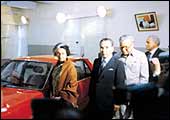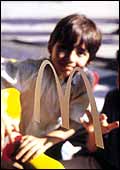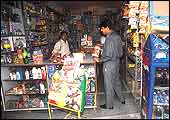|
 Consumers
and rights? Indian manufacturers would have laughed at you if you
asked that question as late as a decade ago. Actually, many will
hold their sides even today. But the laughter is fading. Aggressive
consumers, proactive consumer courts, and cut-throat competition
are ensuring a new age. Consumers
and rights? Indian manufacturers would have laughed at you if you
asked that question as late as a decade ago. Actually, many will
hold their sides even today. But the laughter is fading. Aggressive
consumers, proactive consumer courts, and cut-throat competition
are ensuring a new age.
So it might surprise you to know that the consumer
movement in India had its roots in the early part of 20th century
with the formation of Passengers and Traffic Relief Association,
and Women Graduates Union in Bombay in 1915. The real impetus, in
terms of sustained and visible campaigns and expansion, came only
around the sixties, with the setting up of The Consumer Guidance
Society Of India (CGSI), All India Bank Depositor's Association,
Bombay Civil Trust, and the Surat Consumer Association. It was around
the same time that US President John F. Kennedy reiterated his total
commitment to promotion and protection of consumer interests, and
the subsequent creation of The International Organisation of Consumers
Union.
In 1969, the Monopolies and Restrictive Trade
Practices Commission (MRTPC) was set up under the MRTP Act of 1969.
MRTPC was given powers to grant interim relief, and in the absence
of other quick and inexpensive redressal means, the commission filled
a necessary void.
It was only in mid 1970s that consumer activism
arrived in the country, what with Mrinal Gore-also known as Paniwali
Bai (for her vociferous protests against the water shortage
in Mumbai city), altered its face by using political means in resorting
to dharnas and picketing. In 1976 Pune Grahak Panchayat was formed
which used Gore's in-your-face method to fight the rampant food
adulteration in their city. During 1977-80 with Mohan Dharia and
later A.K. Anthony as Consumer Affairs Ministers the movement received
a fillip.
In the eighties, the number of consumer groups
increased rapidly and today their number stands at 1,500. ''The
number can be deceptive as consumer awareness is limited to the
urban pockets; the situation is still very bad in the rural and
semi-urban areas,'' notes prominent consumer activist, Pushpa Girimaji.
In a landmark development in 1986 during Rajiv
Gandhi's tenure, the Parliament passed the Consumer Protection Act
(copra). And that put India in a unique position creating three
tiers of consumer courts-district, state, and national level- with
different levels of pecuniary jurisdiction. The powers of these
courts were only compensatory and not punitive. The Voluntary Consumer
Organisations (VCOs) have a locus standi in these courts and no
fee is charged. Another milestone during the early nineties was
the development of synergy among the VCOs with the formation of
both state and national level federations. It began with Tamil Nadu
in 1990, followed by Gujarat, Orissa, West Bengal, and Andhra Pradesh.
The nineties saw judicial activism of the kind
that helped further consumer rights on a much grander scale. In
its landmark judgement, the Supreme Court in 1999 came to the rescue
of Delhi's populace by ordering a ban on diesel-run commercial vehicles
and relocation of small industries out of residential areas. Since
then, the highest courts of the land have been remarkably active
in providing the Indian consumer relief from the inefficiences of
government and business.
From here on, there will of course be the odd
holdover, but for the consumer, there will be no looking back.
-T.R. Vivek
 |
| With hypermarkets having arrived, shopping is
now an event |
What Does An Urban Household
Spend On?
Food and general
provisions still take up a chunk of the monthly budget, and most
Indian households are also spending a lot on family entertainment.
As expected, children's education remains a very high-spend area.
Travelling and vehicle-maintenance account for a significant expenditure
head, perhaps a reflection of the sorry state of our public transport
systems. The real surprise, however, is the spend on servicing loans
and interest payments, which is next only to food and utility bills.
Has the credit culture arrived?
The Potential Of The Middle-Class Spiral
The socio-economic
structure of urban India remains bottom-heavy, with sec d households
accounting for over 40 per cent. However, the pyramid shows signs
of bulging at the middle, with sec b and c households accounting
for another 40 per cent. There is enough room for all kinds of markets
to flourish, right from luxury goods targetting the nearly two-million
sec a1 households, to small-size, low-value packaged goods in tea/soap/shampoo
and even cough syrup, now in pouches, targeted at sec c, d, and
e. But do your homework well, because the sec categorisation does
not take that all important factor, income, into consideration.
PHASES
IN INDIAN CONSUMERISM: A TIMELINE
The progress from a colonised identity to a demanding customer.
 |
| Spencer's the first retailer |
1863 India's first organised retailer
Durant & Spencer sets up shop in Chennai
1953 Air India launched
1953 Indian Airlines launched
1957 Hindustan Motors starts manufacturing
the Ambassador
1961 Bajaj Auto starts manufacturing
scooters
1977 Coca-Cola exits India after being
asked to disclose concentrate formula
1978 India's first television commercial
aired
 1982
Introduction of colour transmission on television 1982
Introduction of colour transmission on television
1982 Food Specialities Ltd launches
Maggi instant noodles
1983 Maruti 800 is launched
 |
| Indira Gandhi at the Maruti launch |
1984 Country's first 100 cc bike, Hero
Honda CD 100, rolls out
1985 Minicomp launches India's first
personal computer
1990 Pepsi Cola is launched
1991 With the Gulf war raging in the
backdrop, satellite TV enters the Indian household; Visa launches
the first credit card in India
1992 Launch of the first private airline,
Damania Airways
 1993
Private FM channels take time slots on AIR. Coke returns to India
after liberalisation 1993
Private FM channels take time slots on AIR. Coke returns to India
after liberalisation
1995 ATMs spring up; Hutchison Max launches
India's first cellular service in Mumbai
1996 McDonald's opens its first Indian
restaurant at Vasant Vihar New Delhi. A 1.5 km-long queue forms
outside
1997 Toll-free telephone services introduced
2001 Quantitative restrictions abolished.
Foreign consumer goods flood markets. Insurance sector privatised
The Reign Of The Kirana
Store
For all the hype
associated with the huge Rs 60,000-crore opportunity waiting for
organised retail in the country, the Indian consumer still shops
at the street-corner kirana store for her groceries and gives those
spanky new shopping-malls a miss. The dusty ubiquitous bazaars lord
it over the urban landscape.
 |
| A Walmart won't be able to shake this foundation
of the economy |
For all the investments that most branded apparel
marketers have made on exclusive and franchised stores to provide
the consumer a ''complete brand experience'', nearly 80 per cent
of all apparel sold in the country is still bought from independent
mom-and-pop multi-brand stores. Ditto for consumer durables. The
only exception is footwear, where nearly 45 per cent prefer an exclusive
brand store, perhaps indicating the category's pre-sold status,
primarily because there was so little to compare between brands,
anyway.
But surely Indian retail habits are changing.
Organised retailers like RPG Group Shoppers' Stop and Tata's Westside,
are quickly adding economy of purchase, the hitherto missing link
of organised retail in the country, with ease and experience of
shopping. Shopping may prove less expensive at organised retailers,
what with discount store-format retailing making an entry late last
year with the launch of Big Bazaar by Pantaloon Fashions in Kolkata,
Hyderabad, and Bangalore.
-Shailesh Dobhal
|

